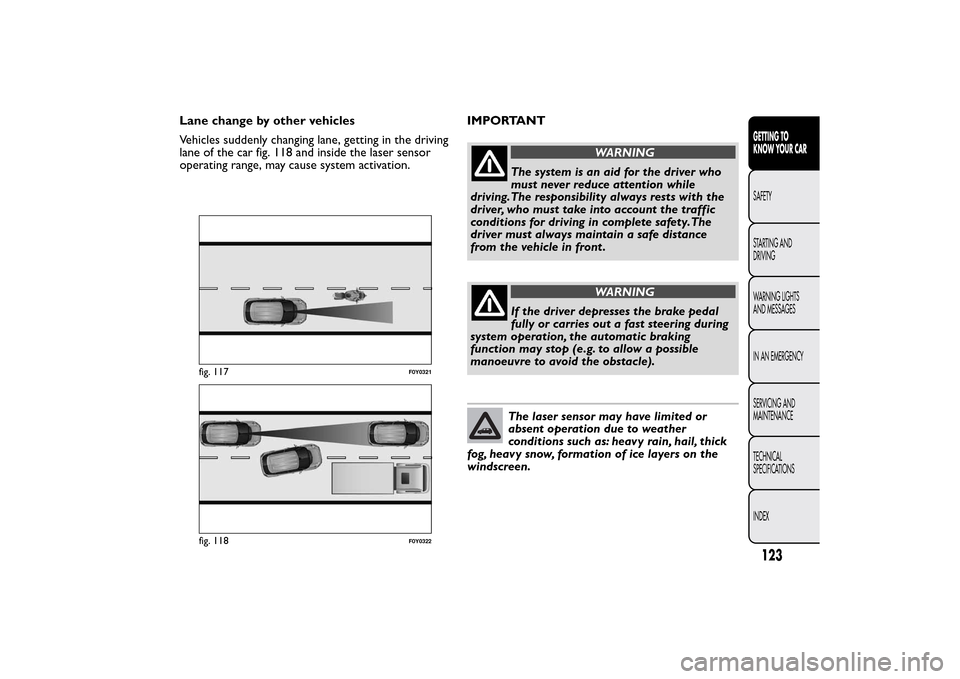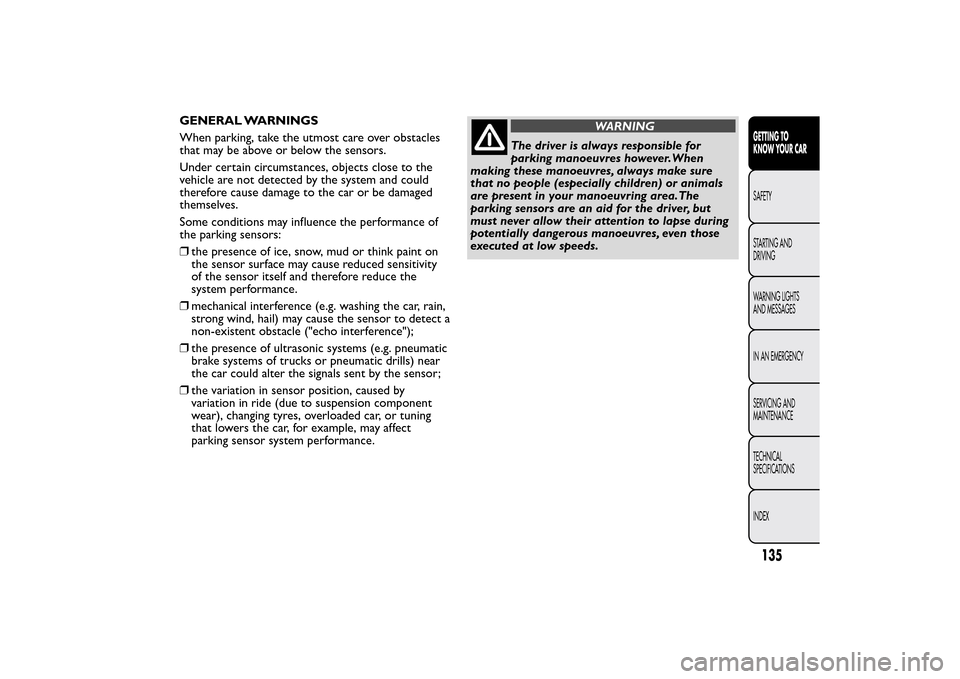2014 FIAT 500L LIVING ESP
[x] Cancel search: ESPPage 122 of 420

The LED above the
button is on when the system
is deactivated.
ENGINE STOPPING FAILURE CONDITIONS
When the system is operating, due to comfort,
emission control and safety reasons, the engine does
not stop in some conditions, among which:
❒engine still cold;
❒especially cold outside temperature;
❒battery not sufficiently charged;
❒particulate filter regeneration (DPF) in progress
(diesel engines only);
❒driver's door not shut;
❒driver's seat belt not fastened;
❒reverse gear engaged (for example, for parking
manoeuvres);
❒for versions equipped with automatic climate
control (for versions/markets, where provided), if
an adequate level of thermal comfort has not
been reached or with MAX-DEF mode active;
❒during the first period of use, to initialise the
system.
If climate comfort is to be favoured, the
Start&Stop system can be disabled, for
a continuous operation of the climate
control system.ENGINE RESTARTING CONDITIONS
For reasons of comfort, limiting harmful emissions
and safety purposes, the power unit can restart
automatically without any action on behalf of the
driver if certain conditions are met, including:
❒battery not sufficiently charged;
❒reduced braking system vacuum (e.g. if the brake
pedal is pressed repeatedly);
❒car moving (e.g. when driving on roads with a
gradient);
❒engine stopping by Start&Stop system for over 3
minutes;
❒for versions equipped with automatic climate
control (for versions/markets, where provided), if
an adequate level of thermal comfort has not
been reached or with MAX-DEF mode active.
With gear engaged, automatic engine restarting is
possible only by fully depressing the clutch pedal. The
operation is signalled to the driver with a message
shown on the display.
Notes
If the clutch is not pressed, about 3 minutes after the
engine stops, the engine can be restarted only using
the ignition key.
In cases of unwanted engine stop, due for example to
the clutch pedal being released sharply with a gear
engaged, if the Start&Stop system is active, the
engine can be restarted by fully depressing the clutch
pedal or by placing the gear lever in neutral.
118GETTING TO
KNOW YOUR CAR
SAFETY
STARTING AND
DRIVING
WARNING LIGHTS
AND MESSAGES
IN AN EMERGENCY
SERVICING AND
MAINTENANCE
TECHNICAL
SPECIFICATIONS
INDEX
Page 127 of 420

Lane change by other vehicles
Vehicles suddenly changing lane, getting in the driving
lane of the car fig. 118 and inside the laser sensor
operating range, may cause system activation.IMPORTANT
WARNING
The system is an aid for the driver who
must never reduce attention while
driving.The responsibility always rests with the
driver, who must take into account the traffic
conditions for driving in complete safety.The
driver must always maintain a safe distance
from the vehicle in front .
WARNING
If the driver depresses the brake pedal
fully or carries out a fast steering during
system operation, the automatic braking
function may stop (e.g. to allow a possible
manoeuvre to avoid the obstacle).The laser sensor may have limited or
absent operation due to weather
conditions such as: heavy rain, hail, thick
fog, heavy snow, formation of ice layers on the
windscreen.
fig. 117
F0Y0321
fig. 118
F0Y0322
123GETTING TO
KNOW YOUR CARSAFETY
STARTING AND
DRIVING
WARNING LIGHTS
AND MESSAGES
IN AN EMERGENCY
SERVICING AND
MAINTENANCE
TECHNICAL
SPECIFICATIONS
INDEX
Page 131 of 420

IMPORTANT
IMPORTANT In some circumstances, such as with
ice, snow or mud on the surface of the camera,
the camera sensitivity may be reduced.
IMPORTANT If the tailgate is to be re-painted
following to repairs, make sure the paint does not
get in contact with the camera.
IMPORTANT When parking, take the utmost care
over obstacles that may be above or under the
camera range.
WARNING
The responsibility for parking and other
manoeuvres is always and in any case
charged to the driver.While carr ying out these
manoeuvres, always make sure that no people
(especially children) or animals are in the area
concerned.The camera is an aid for the driver,
but the driver must never allow his/her
attention to lapse during potentially dangerous
manoeuvres, even those executed at low speeds.
Always keep a slow speed, so as to promptly
brake in case of obstacles.
It is vital, for correct operation, that the
camera is always kept clean and free from
any mud, dirt , snow or ice. Be careful not
to scratch or damage the camera while cleaning
it . Avoid using dry, rough or hard cloths.The
camera must be washed using clean water, with
the addition of car shampoo if necessary. In
washing stations which use steam or high-
pressure jets, clean the camera quickly, keeping
the nozzle more than 10 cm away from the
sensors. Also, do not apply stickers to the camera.
127GETTING TO
KNOW YOUR CARSAFETY
STARTING AND
DRIVING
WARNING LIGHTS
AND MESSAGES
IN AN EMERGENCY
SERVICING AND
MAINTENANCE
TECHNICAL
SPECIFICATIONS
INDEX
Page 133 of 420

When the CITY function is on, the steering wheel
effort is lighter, parking operations are easier:
therefore this function is particularly useful for
driving in city centres.
WARNING
It is absolutely forbidden to carr y out
any after-market operation involving
steering system or steering column
modifications (e.g.: installation of anti-theft
device) that could badly affect performance and
safety, invalidate warranty and also result in
non-compliance of the car with type approval
requirements.
IMPORTANT During parking manoeuvres requiring a
lot of steering, the steering may become harder;
this is normal and is due to the intervention of the
system to protect the electric steering motor from
overheating. No repair intervention is needed in this
case. When the car is used again, the power steering
will work normally again.
WARNING
Before performing any maintenance
operations, always turn off the engine
and remove the key from the ignition to lock
the steering column (especially when the car
wheels are not touching the ground). If this
is not possible (for example if the key needs to
be turned to MAR-ON or the engine must be
running), remove the main fuse that protects
the electric power steering.
129GETTING TO
KNOW YOUR CARSAFETY
STARTING AND
DRIVING
WARNING LIGHTS
AND MESSAGES
IN AN EMERGENCY
SERVICING AND
MAINTENANCE
TECHNICAL
SPECIFICATIONS
INDEX
Page 135 of 420

LAVAZZA 500 ESPRESSO
EXPERIENCE SETUP(for versions/markets, where provided)
The setup is in the rear bottle holder compartment,
on central tunnel fig. 124.
For operation of the Lavazza accessory, which can be
ordered from Lineaccessori Fiat, refer to the
documents provided with the kit itself.
For operation refer to the owner's handbook
provided with the kit itself.
WARNING
Use the accessor y with vehicle
stationar y.
Use the accessor y with engine on, in order
to protect the batter y charge. If several
devices absorbing a high amount of
current (e.g. activation of climate control unit or
heated rear window defrosting) are used
simultaneously, the accessor y could fail to
operate.
fig. 124
F0Y0244
131GETTING TO
KNOW YOUR CARSAFETY
STARTING AND
DRIVING
WARNING LIGHTS
AND MESSAGES
IN AN EMERGENCY
SERVICING AND
MAINTENANCE
TECHNICAL
SPECIFICATIONS
INDEX
Page 139 of 420

GENERAL WARNINGS
When parking, take the utmost care over obstacles
that may be above or below the sensors.
Under certain circumstances, objects close to the
vehicle are not detected by the system and could
therefore cause damage to the car or be damaged
themselves.
Some conditions may influence the performance of
the parking sensors:
❒the presence of ice, snow, mud or think paint on
the sensor surface may cause reduced sensitivity
of the sensor itself and therefore reduce the
system performance.
❒mechanical interference (e.g. washing the car, rain,
strong wind, hail) may cause the sensor to detect a
non-existent obstacle ("echo interference");
❒the presence of ultrasonic systems (e.g. pneumatic
brake systems of trucks or pneumatic drills) near
the car could alter the signals sent by the sensor;
❒the variation in sensor position, caused by
variation in ride (due to suspension component
wear), changing tyres, overloaded car, or tuning
that lowers the car, for example, may affect
parking sensor system performance.
WARNING
The driver is always responsible for
parking manoeuvres however.When
making these manoeuvres, always make sure
that no people (especially children) or animals
are present in your manoeuvring area.The
parking sensors are an aid for the driver, but
must never allow their attention to lapse during
potentially dangerous manoeuvres, even those
executed at low speeds.
135GETTING TO
KNOW YOUR CARSAFETY
STARTING AND
DRIVING
WARNING LIGHTS
AND MESSAGES
IN AN EMERGENCY
SERVICING AND
MAINTENANCE
TECHNICAL
SPECIFICATIONS
INDEX
Page 148 of 420

LOAD LIMITERS
To increase occupant safety, the retractors contain a
load limiter to dose the force acting on the chest
and shoulders during the belt restraining action
in the case of frontal collisions.
GENERAL INSTRUCTIONS FOR USING
THE SEAT BELTS
The driver is responsible for respecting, and ensuring
that all the other occupants of the car also respect,
the local laws in force in relation to the use of the
seat belts. Always fasten the seat belts before setting
off.Seat belts must also be worn by pregnant women:
the risk of injury in the event of an accident is greatly
reduced for them and the unborn child if they are
wearing a seat belt.
Pregnant women must position the lower part of the
belt very low down so that it passes over the pelvis
and under the abdomen (see fig. 134). The best
way to protect the unborn child is to protect the
mother. When a safety belt is worn correctly, it
is more likely that the unborn child will not be
injured in an accident. For pregnant women, as for
anyone, it is important to wear the seat belts
correctly.
fig. 134
F0Y0283
144GETTING TO KNOW
YOUR CAR
SAFETY
STARTING AND
DRIVING
WARNING LIGHTS
AND MESSAGES
IN AN EMERGENCY
SERVICING AND
MAINTENANCE
TECHNICAL
SPECIFICATIONS
INDEX
WARNING
The pretensioner may be used only
once. Contact a Fiat Dealership to have
it replaced after it has been deployed.Operations which lead to impacts,
vibrations or localised heating (over 100°C
for a maximum of six hours) in the area
around the pretensioners may damage or deploy
them. Contact a Fiat Dealership should
intervention be necessar y on these components.
Page 154 of 420

GROUP 1
WARNING
The figure is indicative and for assembly
purposes only. Fit the child restraint
system according to the instructions, which must
be included with this type of restraint system.
Children of weight from 9 to 18 kg may be carried in
forward facing seat fig. 138.
WARNING
Child seats with Isofix attachments are
available for a safe anchoring to the
seat without using the car seat belts. For this
type of seats see paragraph "Isofix child seat
setup" in this chapter.GROUP 2
WARNING
The figure is indicative and for assembly
purposes only. Fit the child restraint
system according to the instructions, which must
be included with this type of restraint system.
Children from 15 to 25 kg may use the car seat belts
directly fig. 139.
In this case, the child restraint system is used to
position the child correctly with respect to the seat
belts so that the diagonal belt section crosses the
child’s chest and not the neck, and the lower part is
snug on the pelvis not the abdomen.
fig. 138
F0Y0203
fig. 139
F0Y0204
150GETTING TO KNOW
YOUR CAR
SAFETY
STARTING AND
DRIVING
WARNING LIGHTS
AND MESSAGES
IN AN EMERGENCY
SERVICING AND
MAINTENANCE
TECHNICAL
SPECIFICATIONS
INDEX